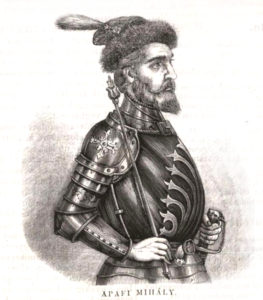Királyházai Nyalábvár

Nyalábvár castle of Királyháza (in Ukrainian: Замок Ньолаб) is one of the earliest Hungarian castles of the Subcarpathian region, it is in Ukraine. As for its village, Királyháza (= “the house of the king”) belonged to the Comes of Ugocsa County. He took care of this forested area on behalf of the Hungarian king, and queen.

The core of the stone castle was presumably built right after the Mongolian Invasion of 1241-42. In the beginning, the castle served as a hunting lodge and an economic center of the surrounding area. It was the time when King Béla IV, the “second founder of Hungary” constructed plenty of stone forts to block the invading tribes from the East.

The first written mention of the castle is from 1264, it was called „Kyralhaza” because the king used to have a stone building on the top of the hill, next to the village. The document was written by the Pope who ordered King István V to return the place to his mother, Laszkarisz Mária, the wife of King Béla IV.

The castle was fully built between 1272 and 1325, it controlled the valley of the Tisza River. The name “Nyalábvár” castle appeared in the documents first in 1315. The castle changed owners quite often in the 14th century. Sometimes we find robber knights among its walls. The Drágffy family got hold of Nyalábvár castle and its area belonging to it in 1378, The Drágffy family was said to be so wealthy that they lent loans even to King Zsigmond. However, King Zsigmond gave the castle and its villages to the Perényi family in 1405. The Perényi family became the third richest Hungarian family in the 16th century, you can read my article about them here:
https://www.hungarianottomanwars.com/essays/lord-perenyi-peter-1502-1548-part-one/
The kingdom was devastated by the peasant uprising of Dózsa György in 1514. The peasants besieged Nyalábvár castle as well but they could not take it. Lady Frangepán Katalin was the wife of Lord Perényi, and she invited Prebend Komjáti Benedek of Pozsony to Nyalábvár castle in the first years of the 1530s. The learned monk was the tutor of Lady Katalin’s son but he also found the time to translate the letters of the Apostle Paul into the Hungarian language. They were published in the printing house of Krakow in Poland in 1533, it was the first printed edition of these letters in the Hungarian language.

Later, Nyalábvár castle gave home to Ilosvai Selymes Péter (cc1520-cc1580), a historian, and a famous author of epic songs. He was of the Reformed faith and served as a schoolmaster in Nagy-Ida which belonged to the Perényi family. He also wrote a work about the life of Apostle Paul, in the Hungarian language. It was first published in 1564 in Szatmár. He was the one who recorded the legend of Toldi Miklós, a famous Hungarian knight of the 14th century. (Please, note that I use the Oriental name order for Hungarians where family names come first.)

During the Ottoman wars, Nyalábvár castle exchanged owners several times between the Habsburg kings of Royal Hungary and the princes of Transylvania. In the beginning, Nyalábvár was in the hand of King Szapolyai, but after his death, the Habsburgs took it away from Queen Isabella, his widow. Later, Prince Báthory István of Transylvania occupied it. Then, it was owned by Prince Bethlen Gábor, and finally, it became the property of the Rákóczi family.

After the unfortunate Polish war of Prince Rákóczi György II, the Ottoman Empire sent their allies, the Crimean Tatars to punish the Transylvanians. They besieged Nyalábvár castle in 1661 but they could not take it. As an act of revenge, they looted Királyháza and its area for a month. Then, they left for Transylvania to continue their destruction, herding plenty of slaves with them. You can read more about Rákóczi’s war of 1657 here:
Many assemblies of Ugocsa County were held in Nyalábvár. Sadly, after the anti-Habsburg conspiration of Lord Wesselényi was unveiled, the castle got on the list of Emperor Leopold and exploded in 1671-72.
October 10, 1677 Victory over the Imperial Army at Nyalábvár







Come, and visit Nyalábvár in Királyháza
Today, only the ruins of a tower can be seen on the long ridge of the castle’s site, next to a small medieval chapel. The original chapel was exploded by the Soviet troops in 1947 because they regarded it as a “possibly military object”. However, the chapel was rebuilt by the inhabitants of Királyháza in the 1990s.

You can take delight in a scenic view from the hill of the castle. Next to the new Greek Catholic Church, you can find a well-kept tourist road leading to the site. As for the inhabitants of Királyháza, the Hungarians had been there in more significant numbers before 1918. Their rate has greatly decreased since then and the Hungarian school was closed in 1944 by the Soviets. Yet, there are still Hungarians living there, according to visitors.

Source: Szibler Gábor, and the Hungarian article of Nyalábvár on Wikipedia and http://www.magyarorszag-szep.hu
Dear Readers, I can only make this content available through small donations or by selling my books or T-shirts.
If you like my writings, please feel free to support me with a coffee here:
You can check out my books on Amazon or Draft2Digital, they are available in hardcover, paperback, or ebook:
https://www.amazon.com/dp/198020490X or at https://books2read.com/b/boYd81

My work can also be followed and supported on Patreon: Become a Patron!http://Become a Patron!
























